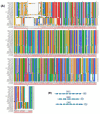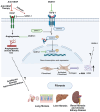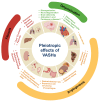Vasohibins in Health and Disease: From Angiogenesis to Tumorigenesis, Multiorgan Dysfunction, and Brain-Heart Remodeling
- PMID: 40497943
- PMCID: PMC12153568
- DOI: 10.3390/cells14110767
Vasohibins in Health and Disease: From Angiogenesis to Tumorigenesis, Multiorgan Dysfunction, and Brain-Heart Remodeling
Abstract
Vasohibins (VASHs), comprising VASH-1 and VASH-2, were initially identified as regulators of angiogenesis. Recent studies, however, have unveiled their novel role in fibrosis and microtubule detyrosination. The dysregulated expression of VASHs is associated with several pathological processes, such as angiogenesis dysfunction, microtubule detyrosination, and fibrosis, contributing to various diseases. These findings suggest the pleiotropic effects of VASHs in multiple organs and systems beyond angiogenesis. This review explores the molecular properties of VASHs and their emerging functions in tubulin carboxyl activity and microtubule detyrosination-key to brain and cardiac remodeling. We also discuss the potential therapeutic applications of their interference in diseases such as tumorigenesis, as well as renal-, reproductive-, and liver-related diseases.
Keywords: angiogenesis regulator; cardiac/brain remodeling; fibrosis TGF-β/SMAD pathway; microtubule detyrosination; vasohibins.
Conflict of interest statement
The authors declare no conflicts of interest.
Figures







Similar articles
-
Vasohibins encode tubulin detyrosinating activity.Science. 2017 Dec 15;358(6369):1453-1456. doi: 10.1126/science.aao5676. Epub 2017 Nov 16. Science. 2017. PMID: 29146869
-
The Tubulin Detyrosination Cycle: Function and Enzymes.Trends Cell Biol. 2019 Jan;29(1):80-92. doi: 10.1016/j.tcb.2018.08.003. Epub 2018 Sep 10. Trends Cell Biol. 2019. PMID: 30213517 Review.
-
Defective tubulin detyrosination causes structural brain abnormalities with cognitive deficiency in humans and mice.Hum Mol Genet. 2019 Oct 15;28(20):3391-3405. doi: 10.1093/hmg/ddz186. Hum Mol Genet. 2019. PMID: 31363758 Free PMC article.
-
Domain architecture of vasohibins required for their chaperone-dependent unconventional extracellular release.Protein Sci. 2017 Mar;26(3):452-463. doi: 10.1002/pro.3089. Epub 2017 Feb 11. Protein Sci. 2017. PMID: 27879017 Free PMC article.
-
The vasohibin family: Novel regulators of angiogenesis.Vascul Pharmacol. 2012 May-Jun;56(5-6):262-6. doi: 10.1016/j.vph.2012.01.002. Epub 2012 Jan 21. Vascul Pharmacol. 2012. PMID: 22286022 Review.
References
Publication types
MeSH terms
Substances
Grants and funding
LinkOut - more resources
Full Text Sources

